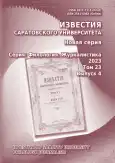Притворная перебранка Дэвида Линдсея
- Авторы: Ибрагимова К.Р.1
-
Учреждения:
- Московский государственный университет имени М. В. Ломоносова
- Выпуск: Том 23, № 4 (2023)
- Страницы: 364-369
- Раздел: Статьи
- URL: https://journals.rcsi.science/1817-7115/article/view/251688
- DOI: https://doi.org/10.18500/1817-7115-2023-23-4-364-369
- EDN: https://elibrary.ru/FEGWDN
- ID: 251688
Цитировать
Полный текст
Аннотация
Ключевые слова
Об авторах
Карина Рашитовна Ибрагимова
Московский государственный университет имени М. В. Ломоносова
ORCID iD: 0000-0002-9639-3261
SPIN-код: 4134-1117
Россия, 119991, Москва, Ленинские горы, д. 1
Список литературы
- Fox D. The Scottish Chaucerians // Chaucer and Chaucerians: Critical Studies in Middle English Literature / ed. by D. S. Brewer. London : Thomas Nelson and Sons, 1966. P. 164–200.
- Princes and Princely Culture: 1450 –1650 / ed. by M. Gosman, A. MacDonald, A. Vanderjagt. Leiden : Brill, 2003. 357 р.
- Матюшина И. Г. Перебранка в древнегерманской словесности. М. : РГГУ, 2011. 304 с.
- Ибрагимова К. Р. Образ поэта в «Перебранке Данбара и Кеннеди» // Stephanos. 2020. № 1 (39). С. 111–117. https://doi.org/10.24249/2309-9917-2020-39-1-111-117, EDN: NJYVTW
- Lyndsay D. Sir David Lyndsay: Selected Poems / ed. by J. H. Williams. Glasgow : University of Glasgow, 2001. 348 p.
- Dunba W. William Dunbar: The Complete Works / ed. by J. Conlee. Kalamazoo, Michigan : Medieval Institute Publications, 2004. 488 р.
- Edington С. Court and Culture in Renaissance Scotland: Sir David Lindsay of the Mount. Amherst : University of Massachusetts Press, 1994. 275 p.
- The Cambridge History of Medieval English Literature / ed. by D. Wallace. Cambridge : Cambridge University Press, 1999. 1043 р.
- Sharpe K. Image Wars: Promoting Kings and Commonwealths in England, 1603–1660. New Haven : Yale University Press, 2010. 512 p.
- Bawcutt P. James VI’s Castalian Band: A Modern Myth // Scottish Historical Review. 2001. № 80. Р. 251–259.
- Rickard J. Writing the Monarch in Jacobean England. Cambridge : Cambridge University Press, 2015. 284 p.
Дополнительные файлы










